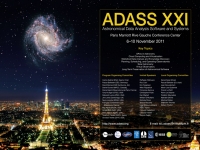Scheduling on the Low Frequency Array (LOFAR) telescope
Alwin De Jong (ASTRON - Netherlands Institute for Radio Astronomy)
Abstract
The newly build LOFAR telescope (www.lofar.org) is an innovative multi-purpose sensor array telescope. Its main application is astronomy at low frequencies (10-250 MHz). LOFAR currently consists of approximately 23 operational core stations, 8 remote stations and 7 international stations that are coupled together via a proprietary high speed optical network. Together these stations form baselines of up to 1500 km throughout Europe. The fast amount of data being produced by the LOFAR antennas runs up to 10 terabit per second. Via the optical network the generated data is send to an IBM Blue-Gene supercomputer where it is further beamformed, correlated and where software pencil beams can be formed.
LOFAR has ten different antenna modes, is supporting multiple parallel station beams, and is able to perform parallel observations observing multiple targets at once. Currently up to hundreds of observations per week are performed and this number is still increasing.
Producing an observational schedule that fulfils all hardware constrains with so many observations every week becomes a daunting task for a human.
Because of the required flexibility and the wish to schedule as compact as possible an automated LOFAR Scheduler has been build. This LOFAR Scheduler software 'knows' all relevant technical parameters and the hardware and software scheduling constrains of the LOFAR telescope. Using a penalty driven simulated annealing algorithm it is able to produce different observation schedules optimized for different operational scheduling goals. The LOFAR Scheduler is supporting the LOFAR telescope operators so they are able to quickly choose between different observing strategies. The Scheduler also supports the operators by keeping track of the current status of the LOFAR hardware such as the stations and storage nodes and is able to quickly adapt the schedule if any of these fail. The execution of the astronomical processing pipelines - that further reduce and process the observational data - is also being scheduled by the scheduler. In this presentation an introduction to this LOFAR scheduling software is presented.Slides in PDF format
Paper ID: O13
|

